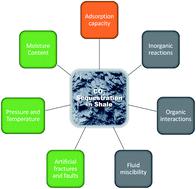当前位置:
X-MOL 学术
›
Environ. Sci.: Processes Impacts
›
论文详情
Our official English website, www.x-mol.net, welcomes your
feedback! (Note: you will need to create a separate account there.)
Geochemical controls on CO2 interactions with deep subsurface shales: implications for geologic carbon sequestration
Environmental Science: Processes & Impacts ( IF 4.3 ) Pub Date : 2021-08-03 , DOI: 10.1039/d1em00109d Shikha Sharma 1 , Vikas Agrawal 1 , Steven McGrath 1 , J Alexandra Hakala 2 , Christina Lopano 2 , Angela Goodman 2
Environmental Science: Processes & Impacts ( IF 4.3 ) Pub Date : 2021-08-03 , DOI: 10.1039/d1em00109d Shikha Sharma 1 , Vikas Agrawal 1 , Steven McGrath 1 , J Alexandra Hakala 2 , Christina Lopano 2 , Angela Goodman 2
Affiliation

|
One of the primary drivers of global warming is the exponential increase in CO2 emissions. According to IPCC, if the CO2 emissions continue to increase at the current rate, global warming is likely to increase by 1.5 °C, above pre-industrial levels, between the years 2030 and 2052. Efficient and sustainable geologic CO2 sequestration (GCS) offers one plausible solution for reducing CO2 levels. The impermeable shale formations have traditionally served as good seals for reservoirs in which CO2 has been injected for GCS. The rapid development of subsurface organic-rich shales for hydrocarbon recovery has opened up the possibility of utilizing these hydraulically fractured shale reservoirs as potential target reservoirs for GCS. However, to evaluate the GCS potential of different types of shales, we need to better understand the geochemical reactions at CO2–fluid–shale interfaces and how they affect the flow and CO2 storage permanence. In this review, we discuss the current state of knowledge on the interactions of CO2 with shale fluids, minerals, and organic matter, and the impact of parameters such as pressure, temperature, and moisture content on these interactions. We also discuss the potential of using CO2 as an alternate fracturing fluid, its role in enhanced shale gas recovery, and different geochemical tracers to identify whether CO2 or brine migration occurred along a particular fluid transport pathway. Additionally, this review highlights the need for future studies to focus on determining (1) the contribution of CO2 solubility and the impact of formation water chemistry on GCS, (2) the rates of dissolution/precipitation and sorption reactions, (3) the role of mineralogical and structural heterogeneities in shale, (4) differences in reaction mechanisms/rates between gaseous CO2 vs. brine mixed CO2 vs. supercritical CO2, (5) the use of CO2 as a fracturing fluid and its proppant carrying capacity and (6) the role of CO2 in enhanced hydrocarbon recovery.
中文翻译:

CO2 与深层地下页岩相互作用的地球化学控制:对地质碳封存的影响
全球变暖的主要驱动因素之一是 CO 2排放量的指数增长。据 IPCC 称,如果 CO 2排放量以目前的速度继续增加,在 2030 年至 2052 年之间,全球变暖可能会比工业化前水平增加 1.5 °C。 高效且可持续的地质 CO 2封存(GCS) ) 为降低 CO 2水平提供了一种可行的解决方案。传统上,不可渗透的页岩地层对 CO 2已为 GCS 注入。用于油气采收的地下富有机质页岩的快速开发开辟了利用这些水力压裂页岩储层作为 GCS 潜在目标储层的可能性。然而,为了评估不同类型页岩的 GCS 潜力,我们需要更好地了解 CO 2 -流体 - 页岩界面的地球化学反应以及它们如何影响流动和 CO 2封存永久性。在这篇综述中,我们讨论了 CO 2与页岩流体、矿物质和有机质相互作用的当前知识状态,以及压力、温度和水分含量等参数对这些相互作用的影响。我们还讨论了使用 CO 2的潜力作为替代压裂液,其在提高页岩气采收率中的作用,以及不同的地球化学示踪剂,以确定 CO 2或盐水迁移是否发生在特定的流体输送路径上。此外,本综述强调未来研究需要重点确定 (1) CO 2溶解度的贡献和地层水化学对 GCS 的影响,(2) 溶解/沉淀和吸附反应的速率,(3)页岩中矿物和结构异质性的作用,(4) 气态 CO 2 与盐水混合 CO 2 与超临界 CO 2之间反应机制/速率的差异,(5) CO 2的使用作为压裂液及其支撑剂承载能力和 (6) CO 2在提高烃采收率中的作用。
更新日期:2021-08-20
中文翻译:

CO2 与深层地下页岩相互作用的地球化学控制:对地质碳封存的影响
全球变暖的主要驱动因素之一是 CO 2排放量的指数增长。据 IPCC 称,如果 CO 2排放量以目前的速度继续增加,在 2030 年至 2052 年之间,全球变暖可能会比工业化前水平增加 1.5 °C。 高效且可持续的地质 CO 2封存(GCS) ) 为降低 CO 2水平提供了一种可行的解决方案。传统上,不可渗透的页岩地层对 CO 2已为 GCS 注入。用于油气采收的地下富有机质页岩的快速开发开辟了利用这些水力压裂页岩储层作为 GCS 潜在目标储层的可能性。然而,为了评估不同类型页岩的 GCS 潜力,我们需要更好地了解 CO 2 -流体 - 页岩界面的地球化学反应以及它们如何影响流动和 CO 2封存永久性。在这篇综述中,我们讨论了 CO 2与页岩流体、矿物质和有机质相互作用的当前知识状态,以及压力、温度和水分含量等参数对这些相互作用的影响。我们还讨论了使用 CO 2的潜力作为替代压裂液,其在提高页岩气采收率中的作用,以及不同的地球化学示踪剂,以确定 CO 2或盐水迁移是否发生在特定的流体输送路径上。此外,本综述强调未来研究需要重点确定 (1) CO 2溶解度的贡献和地层水化学对 GCS 的影响,(2) 溶解/沉淀和吸附反应的速率,(3)页岩中矿物和结构异质性的作用,(4) 气态 CO 2 与盐水混合 CO 2 与超临界 CO 2之间反应机制/速率的差异,(5) CO 2的使用作为压裂液及其支撑剂承载能力和 (6) CO 2在提高烃采收率中的作用。











































 京公网安备 11010802027423号
京公网安备 11010802027423号